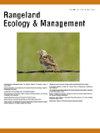Juniperus virginiana Encroachment Could Limit Herbaceous Vegetation in Central Oklahoma
IF 2.4
3区 环境科学与生态学
Q2 ECOLOGY
引用次数: 0
Abstract
Woody plant encroachment (WPE), the advancement of woody plants into rangelands, threatens rangelands globally and negatively impacts ecosystem services important to humans such as causing losses in cattle production and grassland biodiversity. In the Southern Great Plains, Juniperus virginiana L. has become a pervasive and dominant encroaching woody plant. We examined the effect of J. virginiana on rangeland herbaceous vegetation in central Oklahoma. In 2022, we collected herbaceous vegetation data from J. virginiana-encroached grasslands using a balanced, paired design within J. virginiana-dominated and grass-dominated transects. We analyzed the data using linear or generalized linear mixed models. We found that within J. virginiana-dominated transects there was two times less grass and forb cover than in grass-dominated transects. Within J. virginiana-dominated transects, grass, and forb cover were highest at the edge of the tree. We also detected significant differences in woody cover, green herbaceous cover, and average litter depth between J. virginiana-dominated and grass-dominated transects. These findings align with previous studies that indicate that WPE could limit herbaceous vegetation, which could negatively impact cattle production and pollinators. Reducing woody plant density in rangelands is likely necessary to improve cattle production and pollinator habitat, but the occurrence of woody plants in rangelands can also increase cattle production by buffering temperature extremes. Land managers must determine what their objectives are to determine how to manage WPE appropriately. Utilizing land management strategies that promote multiple ecosystems services such as patch burn grazing could be an important tool to manage woody plants effectively.
维吉尼亚杜松的入侵可能限制俄克拉荷马州中部的草本植被
木本植物入侵(WPE),即木本植物向牧场推进,威胁着全球的牧场,并对人类重要的生态系统服务产生负面影响,如造成牛生产和草地生物多样性的损失。在南部大平原,维吉尼亚杜松已经成为一种普遍存在的、占主导地位的侵蚀木本植物。我们研究了弗吉尼亚菊对俄克拉何马州中部草地草本植被的影响。在2022年,我们采用平衡、配对的设计方法,在弗吉尼亚柽柳为主和草为主的样带内收集了弗吉尼亚柽柳侵占的草地的草本植被数据。我们使用线性或广义线性混合模型分析数据。结果表明,在以维吉尼亚菊为优势种的样带中,草和牧草的覆盖面积是草为优势种样带的2倍。在以维吉尼亚树为优势种的样带中,树缘的草和复盖物最高。我们还发现,在以维吉那菊为优势种和以草为优势种的样带中,木质盖度、绿色草本盖度和平均凋落物深度存在显著差异。这些发现与先前的研究一致,表明WPE可能限制草本植被,这可能对牛的生产和传粉媒介产生负面影响。减少牧场的木本植物密度可能是改善牛产量和传粉者栖息地的必要条件,但牧场中木本植物的存在也可以通过缓冲极端温度来增加牛产量。土地管理者必须确定他们的目标是什么,以确定如何适当地管理WPE。利用促进多种生态系统服务的土地管理策略,如斑块燃烧放牧,可能是有效管理木本植物的重要工具。
本文章由计算机程序翻译,如有差异,请以英文原文为准。
求助全文
约1分钟内获得全文
求助全文
来源期刊

Rangeland Ecology & Management
农林科学-环境科学
CiteScore
4.60
自引率
13.00%
发文量
87
审稿时长
12-24 weeks
期刊介绍:
Rangeland Ecology & Management publishes all topics-including ecology, management, socioeconomic and policy-pertaining to global rangelands. The journal''s mission is to inform academics, ecosystem managers and policy makers of science-based information to promote sound rangeland stewardship. Author submissions are published in five manuscript categories: original research papers, high-profile forum topics, concept syntheses, as well as research and technical notes.
Rangelands represent approximately 50% of the Earth''s land area and provision multiple ecosystem services for large human populations. This expansive and diverse land area functions as coupled human-ecological systems. Knowledge of both social and biophysical system components and their interactions represent the foundation for informed rangeland stewardship. Rangeland Ecology & Management uniquely integrates information from multiple system components to address current and pending challenges confronting global rangelands.
 求助内容:
求助内容: 应助结果提醒方式:
应助结果提醒方式:


